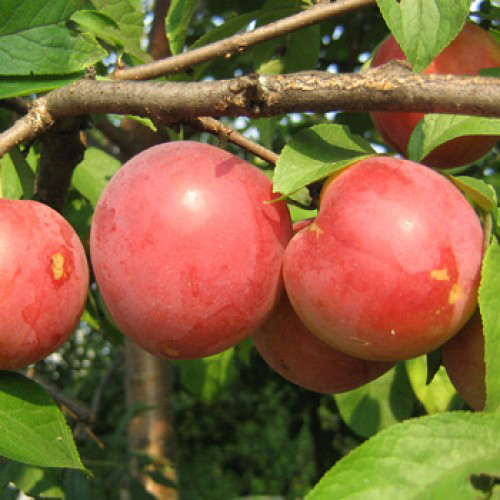Cherry plum variety Tent
In central Russia, no one is surprised by the southern fruit trees growing in gardens. One of them is cherry plum. But not every variety is adapted to develop normally in conditions that are not entirely suitable for culture. In order not to risk in vain and not to experience disappointment, before choosing a suitable variety, try to study the characteristics and capabilities of the plant you have chosen. A variety suitable for a temperate continental climate, many call Shater, which is a seedling of the Fibing plum (Sino-American), a cross-pollinated cherry plum. In 1995, our heroine was entered into the State Register of Breeding Achievements of Russia with admission in the North Caucasus, Lower Volga and Central regions. Originator - Branch Crimean OSS VIR.

Description
A plant of weak growth force, 2 - 3 meters high, flat crown rather dense, slightly drooping. The bark of the trunk is dark gray, with a small number of lentils. The stem is even, medium thick. Shoot 2 - 7 mm thick grows horizontally, on the bark from the illuminated side, the bark is brown-brown, the number of lenticels is average, the shoot tip has no anthocyanin coloration. A spear 5 - 7 cm long. Leaves 60 mm x 37 mm in size, oval, with a very pointed tip and a double-clawed edge with slight waviness. At the beginning of growth, the plate looks up, then takes a horizontal position. The surface of the leaf is wrinkled, slightly shiny, green in color, without pubescence, below the pubescence is weak, concentrated along the central and lateral veins. The petiole has a strong anthocyanin coloration and a deep groove, the pubescence is weak, and there are glands. Petiole size 11 - 14 cm, thickness 1.2 mm. Generative buds are medium-sized, oval in shape, growing, clinging to the shoot. The scales of the blossoming bud are green. Cherry plum inflorescence consists of 2 weakly open flowers with a diameter of 14-15 mm, petals are small, ovoid, white, with a medium fringed edge. Petal width 5.5 mm, length 0.5 mm. On the annual shoot of the Tent, an average number of flowers is formed. 24 stamens, filaments slightly curved, 3 - 5 mm long, yellow anthers, rounded. The stigma of the pistil is rounded, located below the stamens, its length is 9 mm, the bend is weak. Ovary without pubescence. The calyx is not pubescent, bell-shaped. Sepals are oval, 3 mm long, 2 mm wide, bent from the corolla, without pubescence. The stalk is thick and short.
The drupes of the variety are rather large, weighing 32 - 40 grams, broad-ovoid shape, maximum size at the base, height 41 mm, width 39 mm, thickness 40 cm. Cherry plum fruits are slightly asymmetric, with a slightly elongated apex, the abdominal suture deepens towards the base. The funnel is not very deep. The skin is thick and elastic, and it separates from the pulp quite easily. The main color is yellow-red, integumentary solid, violet. Yellow subcutaneous dots evenly cover the surface, their number is average. Low intensity wax coating. The pulp is yellow-green in color, finely grainy-fibrous consistency, medium-dense, moderately juicy, almost never darkens in the air. The aroma is weak. The taste is sweet and sour, and is rated by gardeners as very good. The peduncle is thin, 13 mm long, 1.2 mm thick, without pubescence. The stone is slightly rough, almost smooth, it is difficult to separate from the pulp. 100 grams of raw product contains: sugars 7.1%, acids 2.35%, dry matter 11%, ascorbic acid 7.04 mg. Sugar acid index - 3.0.
Characteristics
- The tent belongs to the early maturing varieties. The harvest ripens in early July. Flowering occurs in mid-April;
- the fruits ripen uncommonly, so the harvest period is delayed. This can create inconvenience for summer residents who visit the plots only on weekends;
- during the fruiting period, cherry plum enters 4 - 5 years after planting;
- the yield for a small plant is excellent. An adult tree is capable of producing 35 - 40 kg of fruit;
- unfortunately, the variety is self-fertile, so pollinators are indispensable.Experienced gardeners in this case recommend planting at least 2 varieties blooming with our hero at the same time. Thus, it will be possible not only to get better quality fruits, but also to increase the productivity of the tree;
- winter hardiness in growing regions, for example, in the Stavropol Territory or the Republic of Karachay-Cherkessia, is quite high. According to reviews, the Tent tolerates spring frosts well. True, some gardeners argue that this figure is still insufficient for the Moscow region, especially in severe winters. To increase winter hardiness, in autumn the trees are fed with phosphorus-potassium fertilizers;
- drought resistance at an average level;
- The State Register notes that the culture is relatively resistant to disease;
- the way of use is universal. Cherry plum is used in its natural form, perfect for canning and processing. Tasters rate juice with pulp at 4.3 points, jam at 4.2 points, compote at 4.1 points.
Agrotechnics
For planting, sunny areas should be allocated so that the crop accumulates sugar. Low and too windy places are not suitable. The soil should have neutral acidity, be loose and fertile. Agricultural technology is common for the culture as a whole. But special attention should be paid to watering, especially during dry periods.
A tent is a great variety for a small area. It is very convenient to care for cherry plum and harvest due to the low growth of the tree. Gardeners highly appreciated the high productivity of the variety and the excellent commercial quality of the fruit, which are suitable for processing. The disadvantages are self-fertility, uneven ripening of the crop and poor separation of the bone from the pulp.








